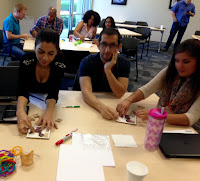 Yesterday (July, 2015) we did a lunch-n-learn at GameStop HQ on pair programming. I think it was a great success, largely because we serve food, and I've been told that everything goes better when people are sharing a meal together (and even better with adult beverages).
Yesterday (July, 2015) we did a lunch-n-learn at GameStop HQ on pair programming. I think it was a great success, largely because we serve food, and I've been told that everything goes better when people are sharing a meal together (and even better with adult beverages).Are you interested in Pair Programming? I'll confess, the term is a bit misleading. I was asked by multiple people if the topic was just for programmers. No - no it's not just a programming technique. It is also for any kind of knowledge work. Such as testing, or analysis, or writing stories, or ... yes coding, scripting, excel spreadsheets, etc.

The Agenda: Pair Programming Simulation
Start with a warm up exercise (totally non-related to the topic). This allows all the late arrivals to find a seat and not miss out on the real start of the session. I've found this technique (soft start) to be a required technique for companies that have not adopted basic meeting protocols, such as finishing prior to the start of the next meeting. IF one does not finish on time, how can one start on time?
We used Thiagi's warm up of Buying Happiness
Flipped this lesson. Although the experiment resulted in a - How Fascinating (failure). No one actually participated in the homework to read the lesson before the experience session. We continued without doing any actual lecture.
PDF - Pair Programming - Lessons
Query the audience - to share the common level of people with respect to the domain knowledge. Ask a few questions - raise your hand if you have heard of pair programming, if you've done pair programming, if you only program in a pairs (every day)? Look around - these are the experts. Raise your hand if you are a beginner? When you read the homework on pairing, you remember that pairing beginners with beginners is an anti-pattern. So what shall we do about that?
Restructure the seating arrangements, have people select appropriate pair for their skill level. Don't allow the beginners to sit together and the experts to create a click.
Part ONE. Pair Drawing.
Let's do the simplest thing that could possibly work... everyone has learned to draw/sketch. Let's use this innate skill to explore pairing basics.PDF - Pair Face Drawing
Most people are afraid to draw. At some point in our traditional schooling we are made ashamed of our ability to draw. With a bit of expert practice many can over come this self imposed limitation. Here's a TED Talk to start you on the path to recovery.
Why people believe they can’t draw - and how to prove they can | Graham Shaw | TEDxHull
Part TWO. Lunch.
Typically what draws everyone to your meeting... food. Don't do Lunch-n-Learn with out this.Part Three. Pair Puzzle Solving.
Let's extend our learning into a harder problem domain... solving a puzzle - Tangrams.
PDF - Pair Puzzle - Tangram Solving
 PDF - Cultivating Collaboration - Simulation via Tangrams - or a starter guide to Pair Programming
PDF - Cultivating Collaboration - Simulation via Tangrams - or a starter guide to Pair Programming
This exercise can touch upon the aspects of Test-First (TDD) practices. Typically a topic for another Lunch-n-Learn.
Debrief.
A great facilitator does the exercise / simulation just to get to the debrief. Reflection is the only activity where double loop learning may occur. Using metaphor and analogy to relate drawing faces or solving Tangrams to developing software is the job of the debrief.


 In a large group with many subgroups this can be done by projecting the debrief question on the screen and having the subgroups (tables) debrief themselves. Extra points given for summaries of learning points or action items discovered.
In a large group with many subgroups this can be done by projecting the debrief question on the screen and having the subgroups (tables) debrief themselves. Extra points given for summaries of learning points or action items discovered.
We did a debrief after each example problem. Then ran out of time to debrief the whole workshop - but did get Level One feedback on the workshop. It was a 8 or 9 (out of 10) with a few improvement to make for next time.
Two Years of Pair Programming by Matt Cholick





Comments